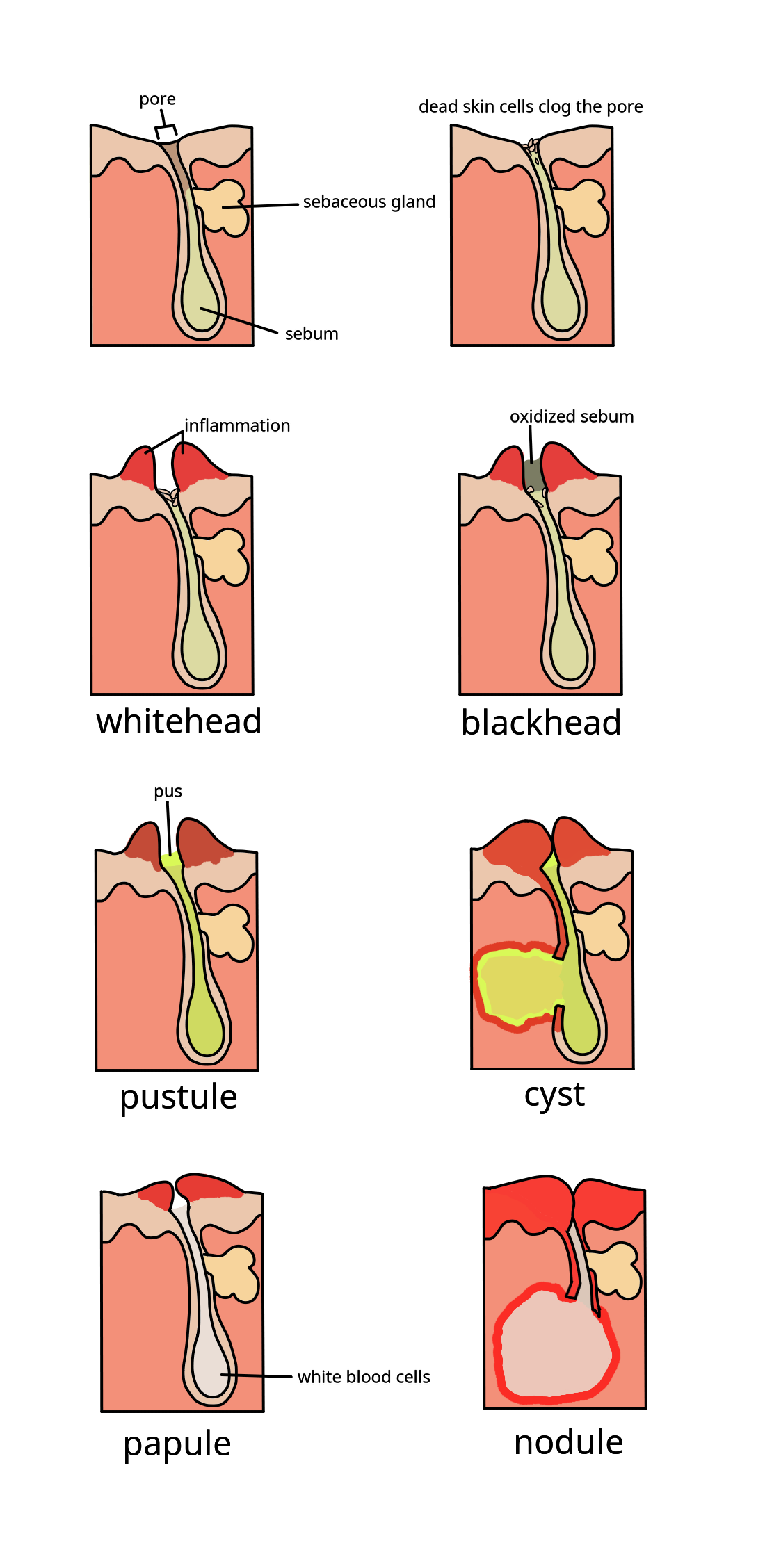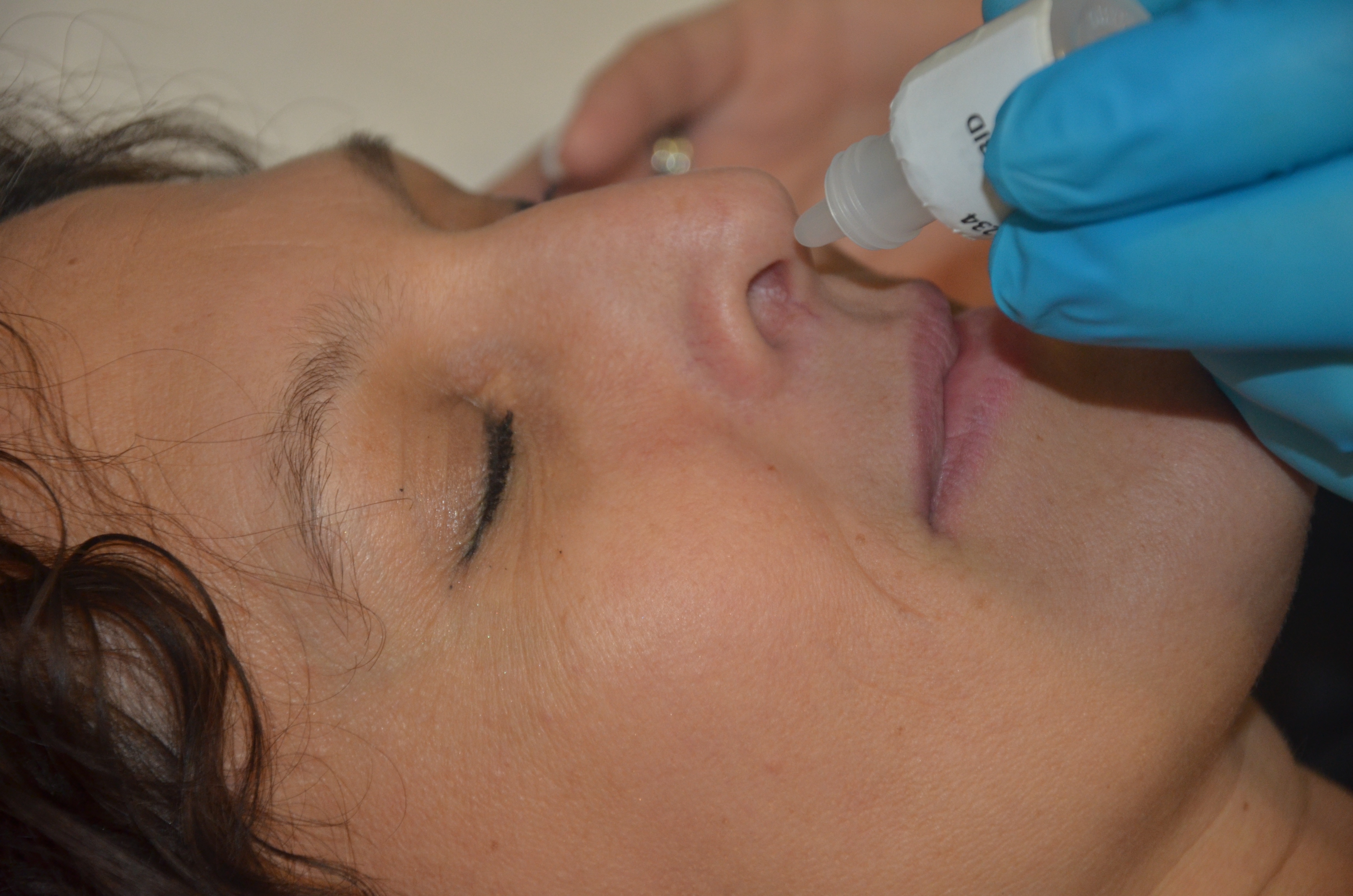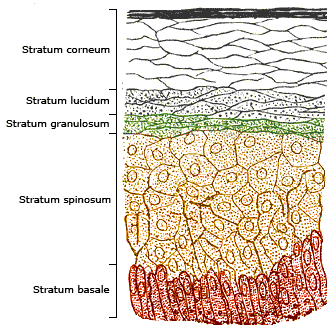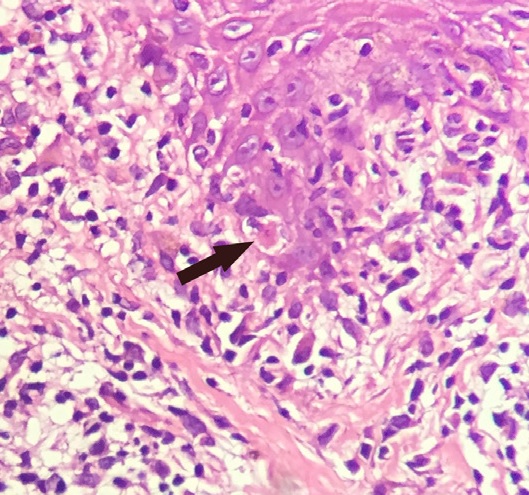|
Tazarotene
Tazarotene, sold under the brand name Tazorac, among others, is a third-generation prescription topical retinoid. It is primarily used for the treatment of plaque psoriasis and acne. Tazarotene is also used as a therapeutic for photoaged and photodamaged skin. It is a member of the acetylenic class of retinoids. Tazarotene was approved for medical use in 1997 and is available as a generic medication. Medical uses Tazarotene is most commonly used topically to treat acne vulgaris and psoriasis. Like other topical retinoids, such as tretinoin and adapalene, tazarotene can be combined with benzoyl peroxide or an oral antibiotic, such as clindamycin or dapsone, for the treatment of acne. This results in increased efficacy compared to tazarotene monotherapy. For psoriasis, a combination therapy of tazarotene and a mid- to high-potency corticosteroid is more effective than either treatment alone. Tazarotene can also be used for the treatment of photodamaged skin. It can reduce ... [...More Info...] [...Related Items...] OR: [Wikipedia] [Google] [Baidu] |
Acne
Acne ( ), also known as ''acne vulgaris'', is a long-term Cutaneous condition, skin condition that occurs when Keratinocyte, dead skin cells and Sebum, oil from the skin clog hair follicles. Typical features of the condition include comedo, blackheads or whiteheads, pimples, oily skin, and possible scarring. It primarily affects skin with a relatively high number of sebaceous gland, oil glands, including the face, upper part of the chest, and back. The resulting appearance can lead to lack of confidence, anxiety (mood), anxiety, reduced self-esteem, and, in extreme cases, clinical depression, depression or suicidal ideations, thoughts of suicide. Susceptibility to acne is primarily genetic in 80% of cases. The roles of diet and cigarette smoking in the condition are unclear, and neither hygiene, cleanliness nor exposure to sunlight are associated with acne. In both sexes, hormones called androgens appear to be part of the underlying mechanism, by causing increased production ... [...More Info...] [...Related Items...] OR: [Wikipedia] [Google] [Baidu] |
Benzoyl Peroxide
Benzoyl peroxide is a chemical compound (specifically, an organic peroxide) with structural formula , often abbreviated as (BzO)2. In terms of its structure, the molecule can be described as two benzoyl (, Bz) groups connected by a peroxide (). It is a white granular solid with a faint odour of benzaldehyde, poorly soluble in water but soluble in acetone, ethanol, and many other organic solvents. Benzoyl peroxide is an oxidizer, which is principally used in the production of polymers. Benzoyl peroxide is mainly used in production of plastics and for bleaching flour, hair, plastics and textiles. As a bleach, it has been used as a medication and a water disinfectant. As a medication, benzoyl peroxide is mostly used to treat acne, either alone or in combination with other treatments. Some versions are sold mixed with antibiotics such as clindamycin. It is on the World Health Organization's List of Essential Medicines. It is available as an over-the-counter and generic med ... [...More Info...] [...Related Items...] OR: [Wikipedia] [Google] [Baidu] |
Photoaging
Photoaging or photoageing (also known as "dermatoheliosis") is a term used for the characteristic changes to skin induced by chronic Ultraviolet, UVA and UVB exposure. Effects of UV light Molecular and genetic changes UVB rays are a primary mutagen that can only penetrate through the epidermis (skin), epidermal (outermost) layer of the skin and can cause DNA mutations. These mutations arise due to chemical changes within skin cells. These mutations may be clinically related to specific signs of photoaging such as wrinkling. Melanocytes and basal cells are embedded in the epidermal layer. Upon exposure to UVB rays, melanocytes will produce more melanin, a pigment that gives skin its color. UVB can cause the formation of freckles and dark spots, both of which are symptoms of photoaging; these are most common in people with fair or light skin. With frequent long-term exposure to UVB rays, signs of photoaging might appear and precancerous lesions or skin cancer may develop. UVA ... [...More Info...] [...Related Items...] OR: [Wikipedia] [Google] [Baidu] |
Topical
A topical medication is a medication that is applied to a particular place on or in the body. Most often topical medication means application to body surfaces such as the skin or mucous membranes to treat ailments via a large range of classes including creams, foams, gels, lotions, and ointments. Many topical medications are epicutaneous, meaning that they are applied directly to the skin. Topical medications may also be inhalational, such as asthma medications, or applied to the surface of tissues other than the skin, such as eye drops applied to the conjunctiva, or ear drops placed in the ear, or medications applied to the surface of a tooth. The word ''topical'' derives from Greek τοπικός ''topikos'', "of a place". Justification Topical drug delivery is a route of administering drugs via the skin to provide topical therapeutic effects. As skin is one of the largest and most superficial organs in the human body, pharmacists utilise it to deliver various dr ... [...More Info...] [...Related Items...] OR: [Wikipedia] [Google] [Baidu] |
Mometasone Furoate
Mometasone, also known as mometasone furoate, is a steroid (specifically, a glucocorticoid) medication used to treat certain skin conditions, hay fever, and asthma. Specifically it is used to prevent rather than treat asthma attacks. It can be applied to the skin, inhaled, or used in the nose. Mometasone furoate, not mometasone, is used in medical products. Common side effects when used for asthma include headache, sore throat, and Candidiasis, thrush. It is therefore recommended to rinse the mouth after use. Long-term use may increase the risk for glaucoma and cataracts. Common side effects when used in the nose include upper respiratory tract infections and nose bleeds. Common side effects when applied on the skin include acne, skin atrophy, and itchiness. It works by decreasing inflammation. Mometasone furoate was patented in 1981 and came into medical use in 1987. It is on the WHO Model List of Essential Medicines, World Health Organization's List of Essential Medicines ... [...More Info...] [...Related Items...] OR: [Wikipedia] [Google] [Baidu] |
Fluocinonide
Fluocinonide is a potent glucocorticoid used topically as an anti-inflammatory agent for the treatment of skin disorders such as eczema and seborrhoeic dermatitis. It relieves itching, redness, dryness, crusting, scaling, inflammation Inflammation (from ) is part of the biological response of body tissues to harmful stimuli, such as pathogens, damaged cells, or irritants. The five cardinal signs are heat, pain, redness, swelling, and loss of function (Latin ''calor'', '' ..., and discomfort. A common potential adverse effect is skin atrophy (thinning of the skin). In 2022, it was the 266th most commonly prescribed medication in the United States, with more than 1million prescriptions. Veterinary uses Fluocinonide is used in veterinary medicine. It is a treatment for allergies in dogs. Natural systemic cortisol concentrations can be suppressed for weeks after one week of topical exposure. References {{Authority control Acetate esters Acetonides Cycloh ... [...More Info...] [...Related Items...] OR: [Wikipedia] [Google] [Baidu] |
RAR-γ
Retinoic acid receptor gamma (RAR-γ), also known as NR1B3 (nuclear receptor subfamily 1, group B, member 3) is a nuclear receptor encoded by the ''RARG'' gene. Adapalene selectively targets retinoic acid receptor beta and retinoic acid receptor gamma and its agonism of the gamma subtype is largely responsible for adapalene's observed effects. Interactions Retinoic acid receptor gamma has been shown to interact with NCOR1. See also * Retinoic acid receptor The retinoic acid receptor (RAR) is a type of nuclear receptor which can also act as a ligand-activated transcription factor that is activated by both all-trans retinoic acid and 9-cis retinoic acid, retinoid active derivatives of Vitamin A. ... References Further reading * * * * * * * * * * * * * * * * * * * {{Retinoid receptor modulators Intracellular receptors Transcription factors ... [...More Info...] [...Related Items...] OR: [Wikipedia] [Google] [Baidu] |
RAR-β
Retinoic acid receptor beta (RAR-beta), also known as NR1B2 (nuclear receptor subfamily 1, group B, member 2) is a nuclear receptor that in humans is encoded by the ''RARB'' gene. Function This gene encodes retinoic acid receptor beta, a member of the thyroid-steroid hormone receptor superfamily of nuclear transcriptional regulators. This receptor localizes to the cytoplasm and to subnuclear compartments. It binds retinoic acid, the biologically active form of vitamin A which mediates cellular signalling in embryonic morphogenesis, cell growth and differentiation. It is thought that this protein limits growth of many cell types by regulating gene expression. The gene was first identified in a hepatocellular carcinoma where it flanks a hepatitis B virus integration site. A deregulation of this gene has also been detected in uterine cervical carcinoma preneoplastic lesions. The gene expresses at least two transcript variants; one additional transcript has been described, but its ... [...More Info...] [...Related Items...] OR: [Wikipedia] [Google] [Baidu] |
Epidermis
The epidermis is the outermost of the three layers that comprise the skin, the inner layers being the dermis and Subcutaneous tissue, hypodermis. The epidermal layer provides a barrier to infection from environmental pathogens and regulates the amount of water released from the body into the atmosphere through transepidermal water loss. The epidermis is composed of stratified squamous epithelium, multiple layers of flattened cells that overlie a base layer (stratum basale) composed of Epithelium#Cell types, columnar cells arranged perpendicularly. The layers of cells develop from stem cells in the basal layer. The thickness of the epidermis varies from 31.2μm for the penis to 596.6μm for the Sole (foot), sole of the foot with most being roughly 90μm. Thickness does not vary between the sexes but becomes thinner with age. The human epidermis is an example of epithelium, particularly a stratified squamous epithelium. The word epidermis is derived through Latin , itself and . ... [...More Info...] [...Related Items...] OR: [Wikipedia] [Google] [Baidu] |
Keratinocyte
Keratinocytes are the primary type of cell found in the epidermis, the outermost layer of the skin. In humans, they constitute 90% of epidermal skin cells. Basal cells in the basal layer (''stratum basale'') of the skin are sometimes referred to as basal keratinocytes. Keratinocytes form a barrier against environmental damage by heat, UV radiation, water loss, pathogenic bacteria, fungi, parasites, and viruses. A number of structural proteins, enzymes, lipids, and antimicrobial peptides contribute to maintain the important barrier function of the skin. Keratinocytes differentiate from epidermal stem cells in the lower part of the epidermis and migrate towards the surface, finally becoming corneocytes and eventually being shed, which happens every 40 to 56 days in humans. Function The primary function of keratinocytes is the formation of a barrier against environmental damage by heat, UV radiation, dehydration, pathogenic bacteria, fungi, parasites, and viruses. Pathoge ... [...More Info...] [...Related Items...] OR: [Wikipedia] [Google] [Baidu] |
Histology
Histology, also known as microscopic anatomy or microanatomy, is the branch of biology that studies the microscopic anatomy of biological tissue (biology), tissues. Histology is the microscopic counterpart to gross anatomy, which looks at larger structures visible without a microscope. Although one may divide microscopic anatomy into ''organology'', the study of organs, ''histology'', the study of tissues, and ''cytology'', the study of cell (biology), cells, modern usage places all of these topics under the field of histology. In medicine, histopathology is the branch of histology that includes the microscopic identification and study of diseased tissue. In the field of paleontology, the term paleohistology refers to the histology of fossil organisms. Biological tissues Animal tissue classification There are four basic types of animal tissues: muscle tissue, nervous tissue, connective tissue, and epithelial tissue. All animal tissues are considered to be subtypes of these ... [...More Info...] [...Related Items...] OR: [Wikipedia] [Google] [Baidu] |





